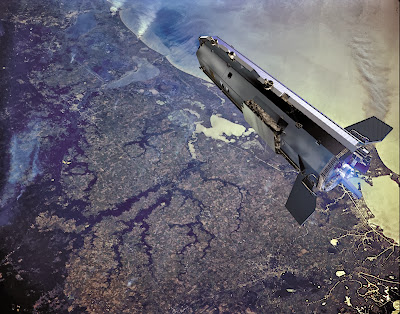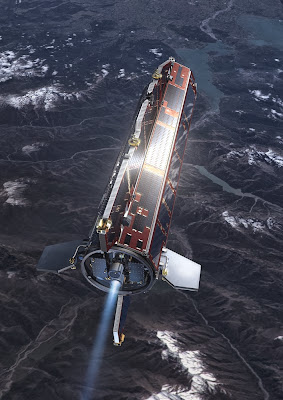ESA’s GOCE mission measured high-accuracy gravity gradients and provided global models of the Earth’s gravity field and of the planet’s geoid.
The accuracy of this type of information is key for surveying and geodesy, and in studies of Earth interior processes, ocean circulation, ice motion and sea-level change.
Credit: AOES Medialab
A European-built satellite built to map Earth's gravity like never before is about to fall victim to the planet's ever-present gravitational pull.
The European Space Agency's Gravity field and steady-state Ocean Circulation Explorer (GOCE) for short, is nearly out of fuel and will make a nosedive to Earth this month after more than four successful years studying the planet's gravitational field.
The doomed GOCE satellite launched in 2009 into a Sun-synchronous, near-circular polar orbit by a Russian Rockot vehicle from the Plesetsk Cosmodrome.
In today’s dollars, the mission is a $475 million effort, including launcher and operations.
The sleek aerodynamic design of GOCE sets it apart from most other satellites.
The unique 16 foot (five meters) long satellite had none of the usual moving parts.
The whole satellite is a single composite gravity-measuring device. Credit: ESA/AOES Medialab
The sleek 1.2-ton (1,100 kilograms) GOCE satellite is outfitted with an Xenon-fueled ion engine that compensated for any drag by generating carefully calculated thrusts.
It skimmed above Earth at a low orbit of about 139 miles (224 kilometers).
GOCE runs out of fuel in the mid- to end of October time period.
Two or three weeks after that, the spacecraft is expected to fall out of orbit and tumble to Earth.
When the uncontrolled GOCE spacecraft plunges through the atmosphere, several pieces of the satellite will likely survive the ensuing fireball and reach the Earth's surface but when and where that space debris will fall is not yet known.
The debris zone area for GOCE's fall from space will be narrowed down closer to the time of spacecraft demise, ESA officials say.
According to ESA estimates, up to 40 to 50 pieces of GOCE — making up about 500 pounds (250 kilograms) of the satellite's full mass — may survive the skyfall.
The accuracy of this type of information is key for surveying and geodesy, and in studies of Earth interior processes, ocean circulation, ice motion and sea-level change.
Credit: AOES Medialab
A European-built satellite built to map Earth's gravity like never before is about to fall victim to the planet's ever-present gravitational pull.
The European Space Agency's Gravity field and steady-state Ocean Circulation Explorer (GOCE) for short, is nearly out of fuel and will make a nosedive to Earth this month after more than four successful years studying the planet's gravitational field.
The doomed GOCE satellite launched in 2009 into a Sun-synchronous, near-circular polar orbit by a Russian Rockot vehicle from the Plesetsk Cosmodrome.
In today’s dollars, the mission is a $475 million effort, including launcher and operations.
The sleek aerodynamic design of GOCE sets it apart from most other satellites.
The unique 16 foot (five meters) long satellite had none of the usual moving parts.
The whole satellite is a single composite gravity-measuring device. Credit: ESA/AOES Medialab
The sleek 1.2-ton (1,100 kilograms) GOCE satellite is outfitted with an Xenon-fueled ion engine that compensated for any drag by generating carefully calculated thrusts.
It skimmed above Earth at a low orbit of about 139 miles (224 kilometers).
GOCE runs out of fuel in the mid- to end of October time period.
Two or three weeks after that, the spacecraft is expected to fall out of orbit and tumble to Earth.
When the uncontrolled GOCE spacecraft plunges through the atmosphere, several pieces of the satellite will likely survive the ensuing fireball and reach the Earth's surface but when and where that space debris will fall is not yet known.
The debris zone area for GOCE's fall from space will be narrowed down closer to the time of spacecraft demise, ESA officials say.
According to ESA estimates, up to 40 to 50 pieces of GOCE — making up about 500 pounds (250 kilograms) of the satellite's full mass — may survive the skyfall.








No comments:
Post a Comment